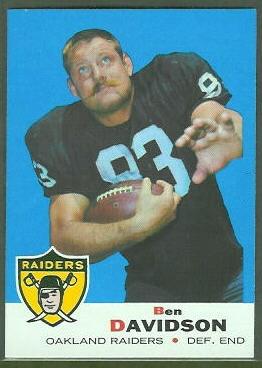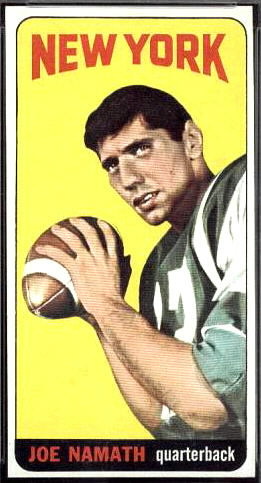 Joe Namath’s 1965 Topps rookie card is easily the most expensive regular issue football card of the 1960s. Come to think of it, it might also be more expensive than any regular issue 1950s card. Why is it so valuable? Well, just being a rookie card of a Hall of Fame player is enough to make it expensive, since collecting Hall of Fame rookie cards is a popular endeavor. (See H is for Hall of Famers.) The 1965 Topps “tall boy” set is also a classic, and one of the most popular vintage sets. And Namath himself, of course, was a flamboyant personality playing on a large market team. Remember his “guarantee” that the Jets would beat John Unitas and the Colts in Super Bowl III? How about his pantyhose ad, and his Noxema ad, with Farrah Fawcett?
Joe Namath’s 1965 Topps rookie card is easily the most expensive regular issue football card of the 1960s. Come to think of it, it might also be more expensive than any regular issue 1950s card. Why is it so valuable? Well, just being a rookie card of a Hall of Fame player is enough to make it expensive, since collecting Hall of Fame rookie cards is a popular endeavor. (See H is for Hall of Famers.) The 1965 Topps “tall boy” set is also a classic, and one of the most popular vintage sets. And Namath himself, of course, was a flamboyant personality playing on a large market team. Remember his “guarantee” that the Jets would beat John Unitas and the Colts in Super Bowl III? How about his pantyhose ad, and his Noxema ad, with Farrah Fawcett?
Still, I have a hard time justifying the price of the Namath card, and it might be another card whose price is inflated by the price guides. (See the Jim Lansford discussion in B is for Bowman.) Just compare Namath’s rookie card to Bart Starr’s 1957 Topps rookie card: the Starr card is only slightly easier to find in high grade than the Namath, 1957 Topps is also a classic set, the Packers won a lot more championships, and most people think Starr was a better quarterback. Yet the Namath sells for two or three times more than the Starr? It seems that either the Namath is overvalued or the Starr is undervalued.
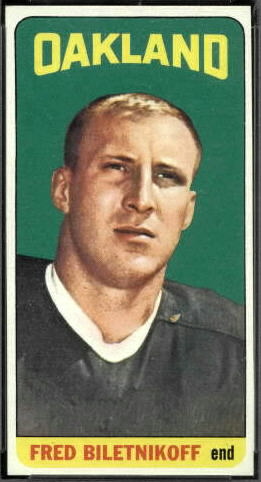 Might the Namath be more valuable because it is a short print? Well, it’s possible that the price guides added a premium for that, but I am not convinced that it even is a short print. The guides say that there are 132 short prints in the set (or 44 double prints, depending on how you look at it), but that sounds fishy to me. Assuming that the 176 cards were released in a single series–and I haven’t read anything to the contrary–my guess is that they were printed on a 198-card sheet, with 22 double prints. I don’t know why Topps would have used more than one sheet if the cards all fit on one. My Beckett catalog isn’t much help; it says merely that “Since this set was not printed in the standard fashion, many of the cards were printed in lesser quantities than the others.” Well, gee, Dr. Beckett, what fashion was it printed in?
Might the Namath be more valuable because it is a short print? Well, it’s possible that the price guides added a premium for that, but I am not convinced that it even is a short print. The guides say that there are 132 short prints in the set (or 44 double prints, depending on how you look at it), but that sounds fishy to me. Assuming that the 176 cards were released in a single series–and I haven’t read anything to the contrary–my guess is that they were printed on a 198-card sheet, with 22 double prints. I don’t know why Topps would have used more than one sheet if the cards all fit on one. My Beckett catalog isn’t much help; it says merely that “Since this set was not printed in the standard fashion, many of the cards were printed in lesser quantities than the others.” Well, gee, Dr. Beckett, what fashion was it printed in?
To see what I’m talking about, you can look at a half-sheet of 1969 Topps basketball cards on the sportscards.info web site. The basketball cards are also tall boys, and the half-sheet of tall boys holds 9 rows of 11 cards, or 99 in total. A full sheet of tall boys would thus hold 198 cards.
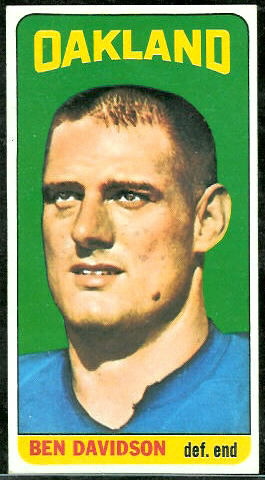 An article on the PSA web site sings the praises of the 1965 Topps set and describes the challenges in finding high-grade cards: poor centering, print marks, etc. Since that article covers the basics, I won’t repeat them here. One point in the article is inaccurate, though, or at least outdated: it says that the set’s two checklists are scarce, and that one of the checklists is the second-most valuable card in the set. PSA’s own population report, however, shows that many of the other cards in the set are scarcer than the checklists in high grades, and some of them sell for more than the checklists. (The last PSA 8 Jim Colclough to sell on eBay, for example, went for $909.) If what I have observed in other sets holds true, the cards most difficult to find in high grades are the ones that were on the corners and edges of the sheets.
An article on the PSA web site sings the praises of the 1965 Topps set and describes the challenges in finding high-grade cards: poor centering, print marks, etc. Since that article covers the basics, I won’t repeat them here. One point in the article is inaccurate, though, or at least outdated: it says that the set’s two checklists are scarce, and that one of the checklists is the second-most valuable card in the set. PSA’s own population report, however, shows that many of the other cards in the set are scarcer than the checklists in high grades, and some of them sell for more than the checklists. (The last PSA 8 Jim Colclough to sell on eBay, for example, went for $909.) If what I have observed in other sets holds true, the cards most difficult to find in high grades are the ones that were on the corners and edges of the sheets.
The PSA article doesn’t mention that there were only eight AFL teams in 1965, so the 1965 Topps set has over 20 cards for each team. That is far more cards per team than most vintage sets provided, and it allowed Topps to print cards for players who typically would not have appeared on a card. In particular, the set contains an unusual number of cards of linemen and defensive players, and many of those are the players’ rookie cards. Pictured here is one example: the only card of defensive back Gerry Bussell. (Thanks to Pastor Scott for this observation–see his comment on D is for Defensive Players.)
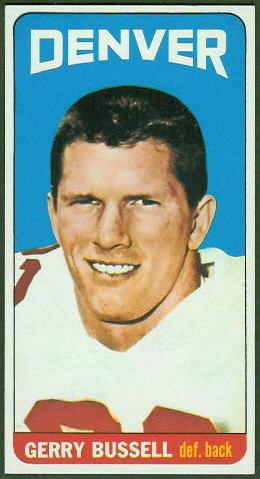 As they did every year from 1960 to 1967, in 1965 Topps grouped the cards by team. I like this feature: first in the set come all of the Patriots, then come all of the Bills, and so on. Also, if I know a player’s team, I can locate his card quickly, even if I don’t know his card number. This is because the teams are in alphabetical order by city, and the players are in alphabetical order within each team. I wonder if it is coincidence that 1960 through 1967 were also the years that Topps had competition in the football card market, and, except in 1960, their competitors grouped the cards by team, as well. In 1968, when Topps again had no competition, they reverted to the random ordering they had last used in 1959.
As they did every year from 1960 to 1967, in 1965 Topps grouped the cards by team. I like this feature: first in the set come all of the Patriots, then come all of the Bills, and so on. Also, if I know a player’s team, I can locate his card quickly, even if I don’t know his card number. This is because the teams are in alphabetical order by city, and the players are in alphabetical order within each team. I wonder if it is coincidence that 1960 through 1967 were also the years that Topps had competition in the football card market, and, except in 1960, their competitors grouped the cards by team, as well. In 1968, when Topps again had no competition, they reverted to the random ordering they had last used in 1959.
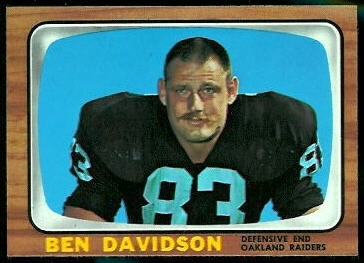 Ben Davidson, a defensive end from 1961 to 1971 for the Green Bay Packers, Washington Redskins, and Oakland Raiders, passed away today. There is a story and photo gallery on the Contra Costa Times web site. Davidson was a member of the Packers’ 1961 NFL Championship team and the Raiders’ 1967 AFL Championship team. He was an AFL All-Star in 1966, 1967, and 1968.
Ben Davidson, a defensive end from 1961 to 1971 for the Green Bay Packers, Washington Redskins, and Oakland Raiders, passed away today. There is a story and photo gallery on the Contra Costa Times web site. Davidson was a member of the Packers’ 1961 NFL Championship team and the Raiders’ 1967 AFL Championship team. He was an AFL All-Star in 1966, 1967, and 1968.